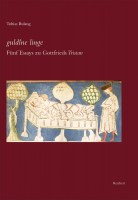Search
guldîne linge
Fünf Essays zu Gottfrieds Tristan
Short Description
In his Tristan novel, Gottfried von Straßburg uses narrative traditions and common motifs of ancient, Celtic, French, Medieval Latin and German traditions. Furthermore, he incorporates aspects of material culture and contemporary scholarly knowledge. This book’s five essays can be read in an arbitrary order. They address different kinds of text-context relations. The aim is to show how such multiple relations contribute to the unique aesthetics and poetics of Gottfried’s fascinating novel.Description
In his Tristan novel, Gottfried von Straßburg uses narrative traditions and common motifs of ancient, Celtic, French, Medieval Latin and German traditions. Furthermore, he incorporates aspects of material culture and contemporary scholarly knowledge. This book’s five essays can be read in an arbitrary order. They address different kinds of text-context relations. The aim is to show how such multiple relations contribute to the unique aesthetics and poetics of Gottfried’s fascinating novel.The first essay (“The Return of Boethius’ Sirens”) explores the siren motifs in Gottfried’s text. Already before Gottfried, sirens were addressed as camenae and identified with muses: in Boethius’ Consolatio Philosophiae the poetical muses are condemned and banished by Philosophy herself, who favors her own philosophical muses instead. In Gottfried’s novel, the sirens banished by Boethius return, and they carry with themselves the passions and their sweet potions that Boethius was fighting against.
The second essay follows the motif of gold throughout the novel (“Poetic Gold”). Gold is a metaphor for perfection, but is also presented in many different forms of its existence: as fabric, sculpture and as metal in alchemical procedures. In Gottfried’s novel, gold becomes a symbol of perfect love, language and poetry.
Tristan’s extraordinary praise of Isolt’s beauty and virtue is the topic of essay number three (“Isolt – New Sun”). Tristan praises Isolt as the new sun of true beauty, which does not rise in Mycenae anymore, but rather ‘here’. Thus, mythological elements, as well as sacral and courtly literature, are quoted. ‘Here’ becomes in Gottfried’s novel the space where the actual poem takes place. It is Gottfried’s novel where the ‘golden’ beauty rises.
The fourth essay deals with the deceptive pillow talks between Mark and Isolt (“Anthropology of Actors”). While the partners try to dominate each other, the true comedy of the conversation lies in the relation to the courtly culture of dissimulatio. Mark and Isolt are speaking deceptively to each other in a space of intimacy, thus reflecting universal anthropological aspects of human expression as well.
The last essay of this book (“rehte güete and guldîne linge”) considers Gottfried’s treatment of allegory. Tristan and Isolt’s utopian love cave has an iron door with a complicated locking mechanism. The symbolic nature of this part, especially its sexual dimension, was a question of research for a long time. The essay shows how multiple references to courtly and sacral, as well as medical literature shape this unique depiction. The aim is to outline the language of Gottfried’s aesthetics of love and art.
Biographical Note
Prof. Dr. Tobias BulangStudied German and Philosophy at the TU Dresden and The Ohio State University in Columbus/OH (USA). 2002 PhD in Dresden with a work about literature and historicism. Between 2003 and 2012 different engagements at the Universities of Göttingen, Dresden, Zurich and Munic. 2009 habilitation in Zurich with a work about medieval and early modern encyclopaedic poetry. Since 2012 Professor for Medieval German Literature at the University of Heidelberg. Editor in Chief of Daphnis. Journal of German Literature and Culture of the Early Modern Period.




 Preface
Preface

 Neuerscheinungen 2023/2024
Neuerscheinungen 2023/2024
 Gesamtverzeichnis 2023/2024
Gesamtverzeichnis 2023/2024
 Katalog Oriental Studies & Linguistics
Katalog Oriental Studies & Linguistics
 Mittelalter
Mittelalter
 Deutsche Inschriften
Deutsche Inschriften
 Musiktherapie
Musiktherapie
 Literaturen im Kontext
Literaturen im Kontext